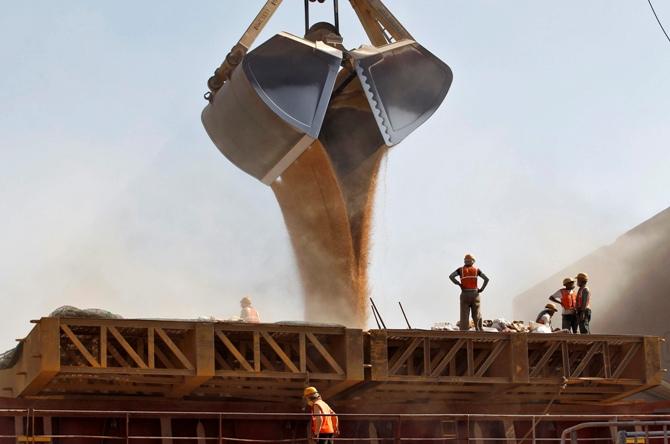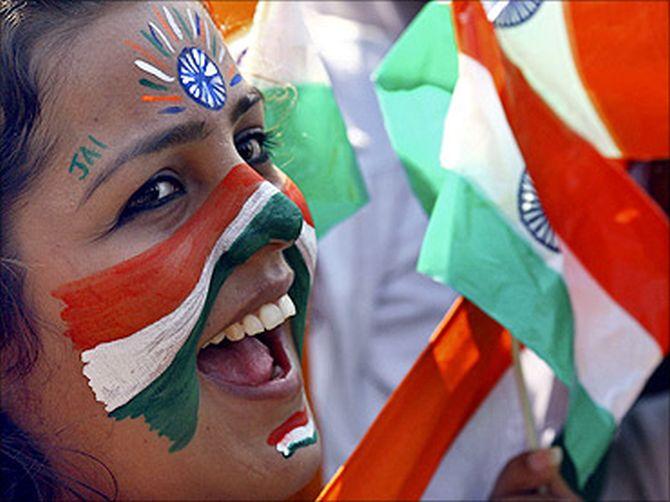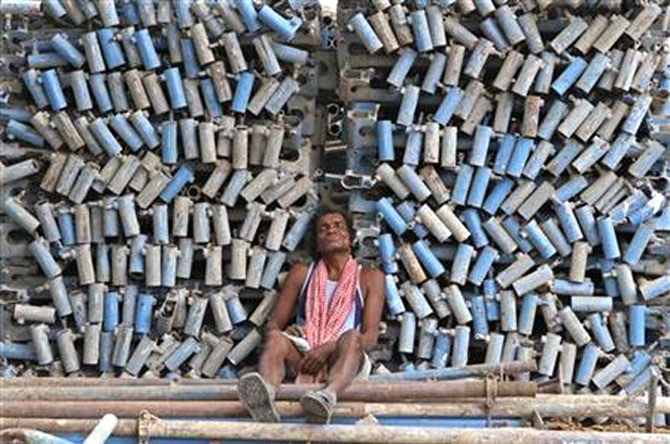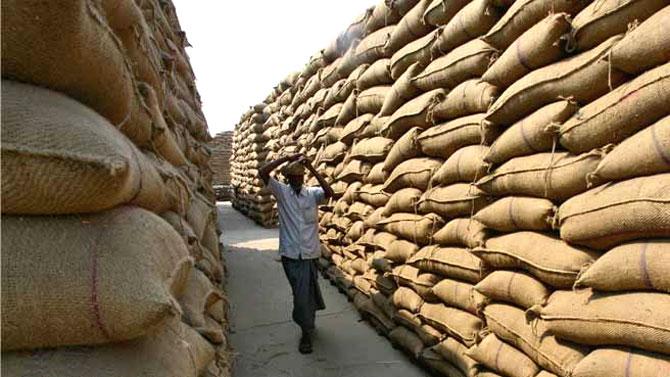Photographs: Amit Dave/Reuters BS Reporter in New Delhi
Analytical firm CRISIL Research said on Sunday it expected the economy to grow by 6.5 per cent yearly, on an average, from 2014-15 to 2018-19 -- roughly the period of the next government if it lasts a full term.
This is way down from the nine per cent annual growth rate from 2003-04 to 2010-11, briefly snapped by the global financial crisis of 2008-09, it said.
Sales of products in various sectors -- automobiles, consumer durables, housing, cement, steel -- would be substantially impacted, as a result.
This would have repercussions on poverty reduction and employment generation, CRISIL said of its study, titled Of Growth and Missed Opportunity.
And, it says, even this ‘base-case forecast’ of 6.5 per cent annual growth ‘is premised on a decisive mandate in the coming general elections’.
. . .
Why India's return to 9% annual growth seems impossible
Image: A worker carries a sack filled with cotton at a wholesale cotton market in Agartala.Photographs: Jayanta Dey/Reuters
If a rag-tag coalition comes, economic growth could be stuck at five per cent annually in the next five years, it cautioned.
The economy crawled at a decadal low of 4.5 per cent in 2012-13 and is officially projected to expand 4.9 per cent in 2013-14.
CRISIL did not rule out economic growth rising above 6.5 per cent, but said there was a ‘natural limit’ to it.
“If everything falls in place, growth could rise much above 6.5 per cent... but nowhere near the nine per cent heyday,” it said.
D K Joshi, its chief economist, attributed this difficulty in returning to nine per cent growth to the bad health of the financial sector, excess capacity in companies (particularly in automobiles), no room for counter-cyclical measures in both monetary and fiscal terms, and pending environmental issues.
. . .
Why India's return to 9% annual growth seems impossible
Image: f the economy grew at five per cent annually, sales would be fewer by four million vehicles.Photographs: Reuters
A 6.5 per cent growth would result in the sale of 16.5 million passenger vehicles (cars, vans, sports utility vehicles) in five years from the current financial year, compared to 18.5 million that would have come if the economy grew by nine per cent a year on an average.
If the economy grew at five per cent annually, sales would be fewer by four million vehicles.
Similarly, 6.5 per cent growth would lead to less sales of scooters by 10 million and of commercial vehicles by 0.5 million, compared to nine per cent growth, it said.
Sales of televisions would be fewer by 13 million, refrigerators by six mn, washing machines by four million and air-conditioners by six million, the research firm said.
As for housing, the study estimated 1.13 million units would be sold in 10 major cities over the next five years, if India managed nine per cent annual growth and only just over 1.03 million units at its projection of 6.5 per cent.
. . .
Why India's return to 9% annual growth seems impossible
Image: The country pulled 140 million people out of poverty, which was the fastest decline in poverty in post-Independence India.Photographs: Reuters
Similarly, it estimated less sale of cement by 125 million tonnes and steel by 42 mt.
Also, it estimated the proportion of people below the poverty line to decline to only 17.3 per cent by 2018-19 from nearly 22 per cent in 2011-12.
“This implies only 6.2 mn people will be pulled out of the morass annually over the next five years, compared with 20 mn between 2004-05 and 2011-12.”
With nine per cent annual growth, India's poverty would have declined sharply to 13.6 per cent of the total by 2018-19, pulling 49 million more -- close to 18 per cent of the current number of the poor -- out of destitution.
The lesser growth rate also meant non-farm employment over the next five years would at best grow by 37 million, it said.
. . .
Why India's return to 9% annual growth seems impossible
Image: The gross domestic product growth is likely to expand six per cent next financial year.Photographs: Ajay Verma/Reuters
On the other hand, in the seven years to 2018-19, India's working age population would have swelled by at least 85 million.
Of these, 51 million would be seeking employment.
This means an additional 14 million will be forced to either depend on low-productivity agriculture or remain unemployed.
Impact of 6.5% economic growth compared to 9% expansion from 2014-15 to 2018-19:
- Less sales of passenger vehicles by 2 million
- Fewer sales of scooters by 10 million; commercial vehicles by 0.5 million; television by 13 million; refrigerators and air conditioners by 6 million; washing machines by 4 million
- Less sale of housing units by 0.1 million in 10 major cities
- Less sale of cement by 125 million tonnes and steel by 42 million tones
- Proportion of people under poverty line to decline to 17.3 per cent by 2018-19 against 13.6 per cent if the economy grows by 9 per cent. The proportion stood at 22 per cent in 2011-12
- Additional 14 million people to be compelled to either depend on low productivity agriculture or remain unemployed
. . .







article